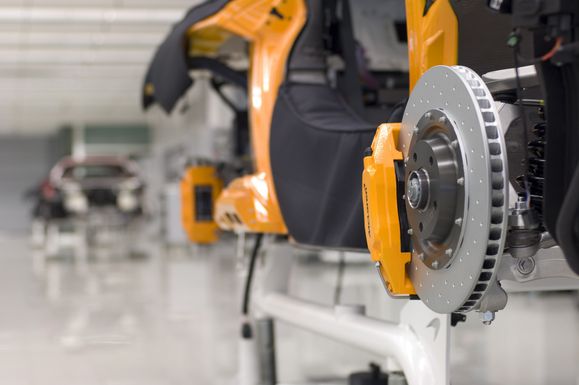 Working to the McLaren mantra of ‘no compromise’, McLaren Automotive’s Vehicle
Dynamics engineers set about creating a brand-new suspension system for a sports car that aims to deliver
Working to the McLaren mantra of ‘no compromise’, McLaren Automotive’s Vehicle
Dynamics engineers set about creating a brand-new suspension system for a sports car that aims to deliver
executive car-like ride quality and a sharp, reactive handling response.
ProActive Chassis Control featuring Adaptive Damping provides much higher stiffness in roll compared to conventional
suspension systems, and greater comfort in a straight line. The suspension is based on double wishbones with coil springs. The dampers are interconnected hydraulically and linked to a gasfilled
accumulator, providing adaptive responses depending on road conditions and driver preference.
Paul Burnham, McLaren Automotive Vehicle Dynamics Manager, said: “It is not enough just to be fast. The 12C has to
innovate in every area. An anti-roll bar is a common and simple solution to support handling, but the disadvantage is that stiffness is always there, whether the driver requires it or not. It is
important to us that the 12C is rewarding and comfortable to drive at low and high speed, on the daily commute and on the track.”
The ProActive system features driver-adjustable roll control which replaces the mechanical anti-roll bars that have been a
standard feature of road cars since time immemorial. It allows the car to maintain precise roll control under heavy cornering while decoupling the suspension in a straight line for excellent
wheel articulation and compliance.
As with the transmission, but independent from it, 12C drivers are able to select ‘Normal’, ‘Sport’ or ‘Track’ settings for
the suspension through the Active Dynamics Panel. Each mode is responsible for managing roll control system pressure, Adaptive Damping and Electronic Stability Control (ESC) settings. This
ensures bespoke tuning between handling, ride and transmission for focused track activity, dynamic road driving, or comfortable cruising.
Burnham continues: “Adaptive Damping works by electronic sensors monitoring the movement of the body and wheels and
only increasing damping when required. We believe Adaptive Damping as part of ProActive Chassis Control is the best system for a driver to set the car to his or her preferred driving modes. Its
speed of response is particularly effective!”
The fundamental principle behind ProActive Chassis Control is simple physics: dampers featuring an
hydraulic system of high and low pressure valves interconnected left to right, front to back. When high pressure meets high
pressure under roll conditions, stiffness results; when high pressure meets low under heave and warp, there is more ‘give’ and comfort prevails.
The 12C controls the balance between roll, heave and warp through a combination of adaptive damping and hydraulic roll
control:
Adaptive damping with hydraulic roll control: a unique damper at each wheel features liquid-filled twin chambers, one a
compression chamber and the other a rebound chamber. The compression chamber of the front-right damper is linked to the front-left damper’s rebound chamber, and the front-left damper compression
chamber is linked to the front-right rebound chamber; likewise at the rear with front and rear dampers linked to ensure an interconnected network .
In roll conditions, the right or left side of the car is prevented from dipping on cornering hard right or hard left
respectively: on cornering hard right with anti-roll bars, the dampers on the right would compress, whilst those on the left extend. With PCC, this is prevented as liquid exits from the front
right damper compression chamber (which is increasing pressure as the car tends towards dipping) and is forced towards liquid exiting from the front left rebound chamber (which is also increasing
pressure as the car tends towards rising on that side), and vice versa at the rear. This results in high-pressure meeting high-pressure, keeping the car on a level, and forcing the liquid to
escape into an accumulator. The accumulator receives the liquid under high pressure where it meets a gas-filled ‘bulb’ separated by a diaphragm. Gas pressure in the diaphragm acts as a
spring
against the relative hydraulic pressures set by the Active Dynamics Panel handling mode where ‘Normal’, ‘Sport’, or ‘Track’
modes increase pressure accordingly. Under ‘N’ there is therefore more ‘give’ in the diaphragm separating the incoming liquid from gas than in ‘S’ or ‘T’ respectively. Thereby controlling the
absolute level of roll, from minimal (‘N’) to virtually zero (‘T’).
Heave: the same concept as per roll, but with dampers working in similar, rather than the opposing actions as in roll where
all are under compression or all under rebound at the same time. In heave, high pressure meets low pressure right to left, and left to right, as high pressure liquid leaving one compression
chamber in one damper is forced into the low pressure environment of the opposing rebound chamber. The result is low roll stiffness, just spring stiffness, tending towards a comfortable
ride.
Warp: a common condition on normal roads where front and rear axle are experiencing varying and opposite roll levels.
Because front right compression or rebound chamber is linked to rear right compression or rebound chamber respectively (and same on the left), which are themselves linked to their opposite
chambers at the front or back respectively, high pressure from the front right under compression, for example, is able to find a low pressure exit either at the rear right under rebound or the
rear left under compression. This tends towards low stiffness on the road and a comfortable ride.
The end result is a car on-track with virtually zero roll as high pressure liquid is forced against high pressure liquid in
the dampers, ‘locking’ the system, but a car on the road that is dynamically tending towards good comfort and ride as high pressure is escaping towards low pressure, keeping the system fluid and
in balance with the road conditions.
Source: Official press release - February 14th 2011.


